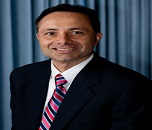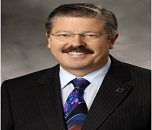Day 1 :
Keynote Forum
Christopher Niezrecki
Chair, Professor, Director - University of Massachusetts Lowell, Center for Wind Energy, Co-director - Structural Dynamics & Acoustic Systems Laboratory
Keynote: Recent advances in wind turbine technologies and sensing for structural health monitoring
Time : 08:50-09:20

Biography:
Dr. Niezrecki is Professor and Chair of Mechanical Engineering at the University of Massachusetts Lowell, the Co-Director of the Structural Dynamics and Acoustics Systems Laboratory, the Director of the Center for Wind Energy at UML, and also the Director of the National Science Foundation-Industry/University Cooperative Research Center for Wind Energy Science, Technology and Research (Windstar). He has been directly involved in structural dynamics, acoustics, smart structures and materials, and sensing research for over 23 years, with more than 100 publications. He has conducted over $11M USD of sponsored research through grants from numerous federal and state agencies as well as several companies.
Abstract:
A significant amount of interest exists in performing wind turbine structural health monitoring, characterization, and evaluation. The presentation highlights some recent advances in optical sensing, acoustic methods, infrared, UAV sensing, and radar technologies that can be applied to characterize wind turbine structural health, structural dynamics, damage, and embedded defects. Non-contacting, full-field surface dynamic measurements are presented that leverage three-dimensional (3D) digital image correlation (DIC), point tracking (PT), and motion magnification methods. The approaches are able to obtain full-field geometry data, in three dimensions. Information about the change in geometry of an object over time can be found by comparing a sequence of images and virtual strain gages (or position sensors) can be applied over the entire visible surface of an object of interest. Non-contact structural dynamic information can be extracted. Results from the structural interrogation of acoustic monitoring, infrared sensing, and radar sensing are also presented on a variety of test objects. Several examples of various sensing technologies are presented on wind turbine rotors and blades. Additionally, some recent advances in wind energy research that originated within the National Science Foundation-Industry/University Cooperative Research Center for Wind Energy Science, Technology and Research (Windstar) will be presented.
Keynote Forum
Winfried Hoffmann
Applied Solar Expertise-ASE, Former president of EPIA, now SolarPower Europe.
Keynote: PV as A major contributor to the 100% renewably powered world
Time : 09:20-10:00

Biography:
Winfried Hoffmann studied solid state physics, diploma in superconductivity and finished with a PhD-thesis in biophysics (laser flash photolysis). He started his industrial career in 1979 at NUKEM/RWE in the area of CdS/Cu2S – Thin-Film solar cells and modules, amorphous Silicon as well as Dye Solar Cells. In the mid-1980s and 90s, a pilot production for MIS-inversion layer c-Si solar cells and large area modules was put in operation. From 1994 he served as Managing Director to "Angewandte Solarenergie - ASE GmbH" (JV DASA and RWE). In the same year the acquisition of 100 % shares of Mobil Solar as a subsidiary company was done with special focus on their developed ribbon EFG technology. In the late 90s the company was renamed RWE Solar and was one of the worldwide 5 biggest production companies. The first inline PE-CVD machines for SiN were developed and built in these years. In 2007 he joined Applied Materials to become Chief Technology Officer and Vice President of the Solar Business Group and member of the Management Board of the German-based Applied Materials GmbH. For many years he was a member in the supervisory board of listed companies (SMA Solar Technology AG and SolarFabrik AG) and was also active in numerous Research Institutes (FhG-ISE, ISFH, Helmholtz Center Berlin, ZSW, and DLR). He served many years in solar associations in order to convince politicians to support the PV market development (German BSW Solar and European EPIA, now SolarPower Europe). Since 2011 he gives lectures about Renewable Energy at the universities Konstanz and Freiburg. In 2012 he received the John Bonda prize from EPIA and the prestigious “European Becquerel Prize for Outstanding Merits in Photovoltaics” from the European Commission. The World Renewable Energy Network (WREN) awarded him as “Solar Pioneer” in 2014.
Abstract:
Only a few years ago it was difficult to explain a world, powered 100% by renewables only – not only electricity but all secondary energy needs, including transportation, heating, and cooling as well as industry needs. The major reason for this was that the production cost for electricity from wind and solar was – although characterized as most elegant - much too high and electricity storage not seen as an option at all. Only with large centralized solar concentrating systems together with hydrogen production (hydrogen economy) or a world-wide distribution system (using high voltage DC current grids) a renewably powered world was seen potentially possible in the very long run. With the rapidly declining cost per produced kWh from PV and wind, together with the push from the automotive sector for Li-ion batteries which also results in a quick reduction of electricity storage cost, there is now – including IoT (Internet of Things) - a new horizon open how to serve man-kinds energy needs rather quickly with renewables only. After analyzing today’s energy needs and how they are served with primary (fossil, nuclear and renewables with ~150 PWh, P=10~15) and secondary energy (electricity, fuel, (process)-heat with ~90 PWh), the future demand for secondary energy is analyzed.
Today’s energy inequity will be changed to a situation where each person on the globe will have a similar energy usage per year, comparable to the living standard today in the industrialized world. An increase in energy efficiency by a factor of 3 will be explained. The global population for the future world is estimated to be ~10 billion according to UN statistics. With this, the future secondary energy offering has to be ~150 PWh per year. The portfolio of renewable energy technologies is discussed and their respective share analysed. PV is seen as one of the prominent technologies in the future, especially when comparing their production cost – more precise: Levelized Cost of Energy - compared with clean fossil and new nuclear power plants, even when including the necessary electricity storage cost. The crucial role for new materials and processes for future solar cells and modules together with the parallel development of storage devices and fuel cells is emphasized. The transition towards 100% renewable energy makes most sense economically, socially and from an energy security point of view. This and the timely coincidence of several break-through technologies will trigger the transformation towards a 100% renewably powered world quicker as many expect also on a global level.
Keynote Forum
Yi-Lung Mo
Chair Professor - University of Houston, USA
Keynote: Carbon nanofiber aggregate sensors for sustaining resilience of nuclear power plants to multi-hazards
Time : 10:00-10:30

Biography:
Dr. Yi-Lung Mo, F.ASCE, F.ACI, F.Humboldt is Professor at the Civil and Environmental Engineering Department, the University of Houston (UH). He is also Tsinghua Chair Professor, Institute of Future City and Infrastructure, Tsinghua University, Beijing, China. His technical interests are multi-resolution distributed analytical simulations, large-scale concrete structure testing and field investigations of the response of complex structures, on which he has more than 400 research publications, including 201 refereed journal papers, many conference, keynote and prestige lectures, research reports, books and book chapters, magazine articles and earthquake field mission reports. In the past several years, he has focused on energy material research, especially the application of carbon nanofiber material for sustaining resilience of nuclear power plants to multi-hazards.
Abstract:
Multi-hazards such as natural hazards (floods, earthquakes, severe storms and wildland fires) or manmade disasters (nuclear disaster, oil spills, and terrorist attacks) lead to substantial damage on critical infrastructures and communities and have social, economic and environmental consequences. The immediate impacts on multi-hazards include loss of human life and damage to infrastructures. Multi-hazard mitigation for nuclear power plants forms a vital input in disaster management, the design of development strategies and emergency response forecasting. In this lecture, we will present how to develop a robust and cost-effective real-time carbon nanofiber aggregate (CNFA) sensor system that can be embedded at nuclear power plants for damage detection during events such as earthquakes, nuclear disasters, and missile attacks, and for water level monitoring in nuclear power plants during flooding. A real-time multi-hazard alert software system will also be developed to monitor the data generated by the CNFA sensors and produce proper alerts when hazardous events are detected. The CNFA acts as a strain sensor. The stresses in the critical regions of nuclear power plants due to natural or man-made hazards can be determined by taking into account the strains developed on the surface of the CNFA. This strain produces an equivalent stress in the CNFA that can be derived from its electrical resistance variation. The CNFA sensor system determines the stresses and strains in nuclear power plants and transmits the information to immediately provide real-time information to decision makers. We will also develop a predictive computational modeling platform, which incorporates various couplings between mechanical, electrical and thermal effects and provides an accurate coupled response (e.g., displacements, stresses, temperature, electrical fields) of nuclear power plants.
